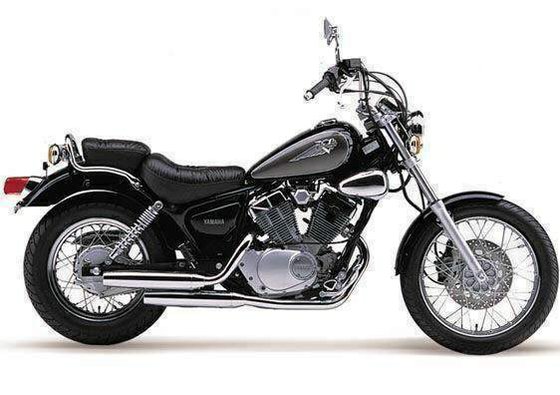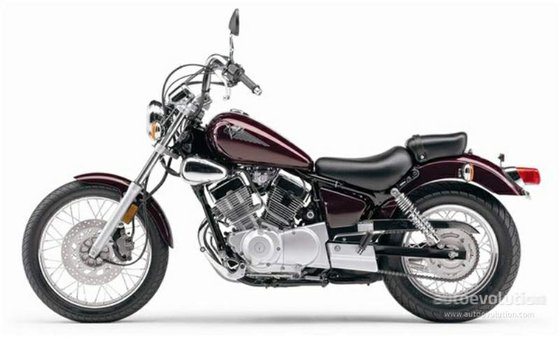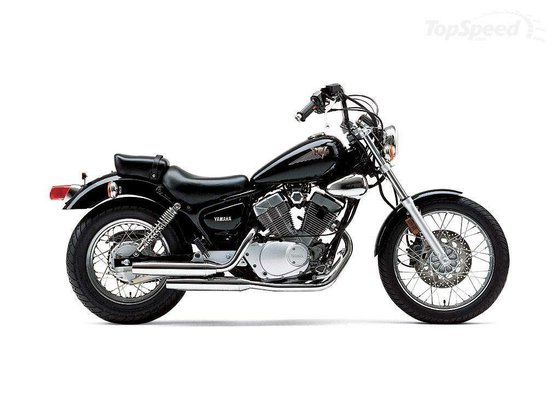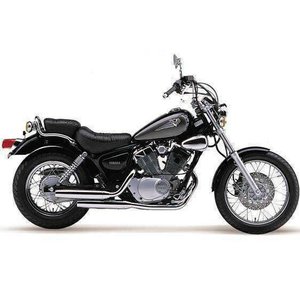Yamaha XV 250 Virago (2008–2022): A Timeless Entry-Level Cruiser With Big-Bike Charisma

Introduction
For over a decade, the Yamaha XV 250 Virago—marketed in some regions as the V Star 250—has been the unsung hero of entry-level cruisers. With its unapologetically retro styling, approachable ergonomics, and a growling V-twin engine that punches above its displacement, this motorcycle has become a rite of passage for new riders and a nostalgic companion for seasoned ones. Let’s dissect why this small-bore cruiser continues to resonate in a market obsessed with bigger, louder machines.
Design & First Impressions

The XV 250 Virago doesn’t just mimic cruiser aesthetics—it embodies them. From the teardrop fuel tank (9.5L / 2.5 gal) to the dual chrome exhausts, Yamaha nailed the "baby V-twin" formula. The 60-degree V-twin engine is the centerpiece, framed by a steel tube frame and laced spoke wheels (3.00-18 front, 130/90-15 rear) that scream classic appeal.
At 147 kg (324 lbs) wet, the bike feels shockingly light when you throw a leg over the 686mm (27-inch) seat—a height that welcomes riders as short as 5’2". The pullback handlebars and forward footpegs create a relaxed riding triangle, while the 2189mm (86.2-inch) wheelbase ensures stability without sacrificing flickability in traffic.
Color options like Raven Black, Frost Silver, and Metallic Silver kept the design fresh over the years, though aftermarket customization is where this bike truly shines (more on that later).
Engine & Performance

Don’t let the 249cc displacement fool you—the air-cooled SOHC V-twin packs character. With a 49.0 x 66.0mm bore/stroke, it prioritizes low-end torque (44.3 lb-ft / 60 Nm at 6,000 RPM) over top-end power (23 HP at 8,000 RPM). The result? A tractor-like pull from stoplights and buttery-smooth shifts through the 5-speed transmission.
The Mikuni 26mm carburetor delivers crisp throttle response, though cold starts occasionally require patience. Fuel efficiency is a standout: 3.02L/100km (77.89 mpg) means 315+ km (195+ miles) per tank—perfect for weekend jaunts.
While the engine vibes intensify past 90 km/h (56 mph), the Virago cruises comfortably at 80-100 km/h (50-62 mph). Top speed hovers around 136 km/h (85 mph), but this bike thrives in urban canyons, not autobahns.
Handling & Ride Experience
The XV 250’s 1491mm (58.7-inch) wheelbase and 32-degree rake strike a balance between stability and agility. Weighing less than a Harley-Davidson Sportster’s front wheel, it dances through traffic and U-turns like a bicycle.
Suspension is basic but effective: a 33mm telescopic fork with 140mm (5.5 inches) of travel up front and dual rear shocks (adjustable preload) handling 99mm (3.9 inches) out back. It soaks up potholes better than pricier cruisers, though rough roads will have you wishing for adjustable damping.
Braking is adequate, with a 282mm front disc (single-piston caliper) doing 80% of the work. The 130mm rear drum lacks bite but is forgiving for new riders. Swap to sintered pads and a steel-braided line for sharper response.
Comfort & Ergonomics
Yamaha’s focus on accessibility shines here. The seat is a two-tier design—narrow at the tank for easy footing, widening at the rear for support. After 90 minutes, you’ll feel the firm foam, but gel inserts or an aftermarket seat solve this.
The forward footpegs and neutral handlebars create a slight lean that’s easy on the back. Wind protection? Non-existent. But that’s part of the charm—this is a motorcycle that demands you feel the ride.
Passengers get a decent perch, though the rear suspension sags noticeably. Cranking up the preload helps, but consider upgrading shocks if two-up riding is frequent.
Competition
Honda Rebel 300: The Rebel’s liquid-cooled 286cc parallel twin and modern tech (ABS, fuel injection) make it a formidable rival. However, it lacks the Virago’s V-twin charisma and customization potential.
Suzuki Boulevard S40: With a 652cc single-cylinder engine, the S40 offers more power but sacrifices refinement. Its vibrations and heavier clutch make the Virago feel like a luxury sedan.
Kawasaki Vulcan S 650: In a higher league price-wise, the Vulcan’s adjustable ergonomics and Ninja-derived engine are brilliant, but it’s 50+ kg (110+ lbs) heavier.
Verdict: The XV 250’s blend of retro styling, approachable mechanics, and lightweight handling keeps it relevant against tech-heavy newcomers.
Maintenance & Ownership
The XV 250 is a carbureted, air-cooled time capsule—simple to maintain but demanding diligence:
- Oil Changes: Every 5,000 km (3,100 miles) with 10W-40. The spin-on filter is easily accessible.
- Chain Care: Lube every 500 km (310 miles); adjust tension to 40-50mm (1.6-2.0 inches).
- Carb TLC: Clean jets annually if ridden sporadically. Consider a carb heater for cold climates.
- Valve Checks: Every 10,000 km (6,200 miles). Shim-under-bucket design requires patience but no special tools.
- Brake Service: Flush fluid every 2 years; inspect drum shoes for glazing.
Common Upgrades at MOTOPARTS.store:
- Exhaust: Slip-on mufflers for deeper acoustics (without dB-killing baffles).
- Seat: Gel inserts or a touring saddle for long rides.
- Suspension: Progressive-rate springs for the rear shocks.
- Lighting: LED turn signals and a brighter headlight bulb.
Final Thoughts
The Yamaha XV 250 Virago isn’t about specs—it’s about soul. It’s the motorcycle that teaches you to appreciate the rumble of a V-twin, the joy of a friction zone clutch, and the pride of owning a bike you can wrench on yourself. While rivals chase modernity, the Virago remains a testament to motorcycling’s purest joys.
Whether you’re a new rider seeking confidence or a veteran craving simplicity, this little cruiser delivers—one throaty, fuel-sipping mile at a time.
Ready to make it yours? Explore our curated selection of XV 250 upgrades at MOTOPARTS.store and keep the V-twin spirit alive.
Specifications sheet
| Engine | |
|---|---|
| Stroke: | Four-stroke |
| Max power: | 17 kW | 23.0 hp |
| Max torque: | 22 Nm |
| Fuel system: | Carburetor, Mikuni 26mm |
| Max power @: | 8000 rpm |
| Displacement: | 249 ccm |
| Fuel control: | SOHC |
| Max torque @: | 6000 rpm |
| Configuration: | V |
| Cooling system: | Air |
| Compression ratio: | 10.0:1 |
| Number of cylinders: | 2 |
| Valves per cylinder: | 2 |
| Dimensions | |
|---|---|
| Wheelbase: | 1490 mm (58.7 in) |
| Dry weight: | 139 |
| Wet weight: | 147 |
| Seat height: | 685 mm (27.0 in) |
| Overall width: | 710 mm (28.0 in) |
| Overall height: | 1060 mm (41.7 in) |
| Overall length: | 2190 mm (86.2 in) |
| Ground clearance: | 145 mm (5.7 in) |
| Fuel tank capacity: | 9.5 L (2.5 US gal) |
| Drivetrain | |
|---|---|
| Final drive: | chain |
| Transmission: | 5-speed |
| Maintenance | |
|---|---|
| Rear tire: | 130/90-15 |
| Engine oil: | 10W-40 (inferred) |
| Front tire: | 3.00-18 |
| Break fluid: | DOT 4 (inferred) |
| Spark plugs: | NGK CR8E (inferred) |
| Spark plug gap: | 0.8 |
| Engine oil capacity: | 2.2 |
| Engine oil change interval: | Every 5000km or 2 years (inferred) |
| Valve clearance (intake, cold): | 0.10–0.20 mm |
| Valve clearance check interval: | 24,000 km / 15,000 mi (inferred) |
| Valve clearance (exhaust, cold): | 0.20–0.30 mm |
| Chassis and Suspension | |
|---|---|
| Frame: | Steel double cradle |
| Trail: | 119 mm (4.7 in) |
| Rear brakes: | 130mm drum |
| Front brakes: | Single 282mm disc, hydraulic |
| Rear suspension: | Twin shocks, adjustable spring preload, 100 mm travel |
| Front suspension: | 33mm telescopic fork, 140 mm travel |
| Rake (fork angle): | 32.0° |



















